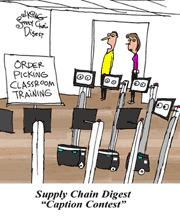Is the Amazon Union Vote Truly Seismic?
The eyes of the world appear to be on Bessemer, Alabama.
That's because officials are busy there counting mail-in ballots from some 6000 workers at an Amazon fulfillment center in this city close to Birmingham as to whether they will join the Retail, Wholesale, and Department Store Union.
The FC has been open less than a year, which actually caused some modest confusion, as I will detail in later paragraphs.
| GILMORE SAYS: |
WHAT DO YOU SAY?'
Does Amazon turn the performance screws tighter than most others? Maybe. There seems to be enough anecdotal evidence in the media reports to think that way.
Send us your
Feedback here
|
If the organizing drive is successful, it will be the first unionized Amazon facility in the US. A few years back, a small number of mechanics briefly tried to unionize in an FC in I believe in Massachusetts, but it was voted down.
A number of Amazon FCs in Europe, notably Germany, are organized.
Many believe this is a seminal vote in the progress or not of unions at Amazon, in retail distribution more generally, and even beyond. So major US and even global media outlets (e.g., New York Times, Wall Street Journal, CNBC, etc.) have provided detailed coverage. The vote is made even more prominent by the fact that the action is happening in a deep "red" state, while at the same time we have a new administration that is very openly touting plans for a very union-friendly policy agenda.
Over the past few years, there have been a handful of high profile organizing efforts, some of which at the time were positioned as "labor's last stand." I will cite the two union votes at a Volkswagen factory in Chattanooga, TN, and a similar effort at a Nissan plant in Mississippi.
Despite major efforts and spending by the United Autoworkers union in each vote, the UAW lost all three elections, even when in the first VW vote plant management was on the side of the union.
There are some interesting threads to this whole story. For example, several months back the NLRB ruled that due to COVID-19 the election would be via mail-in ballot, versus the normal in person vote. That mail-in vote would occur over almost seven weeks, from February to March 29. In person votes generally last a day or two.
Amazon appealed that decision and lost. The mail-in ballot is generally thought to favor union forces because workers can be influenced at home.
The employees leading the union charge do not speak all that much about pay, though an obvious goal they say is to have collective bargaining over wages and benefits. But the larger issues appear to be working conditions, an alleged lack of protections against the virus, claims performance standards are brutal, and that workers are too closely monitored electronically as they perform their tasks.
In February, there were reports Amazon was tempting workers in Bessemer to retire with exit payments of as much as $2000. The theme of these reports was that Amazon would somehow target workers supporting the union and eliminate their votes.
It turns out Amazon inherited this program from on-line retailer Zappos, which was acquired by Amazon in 2009. It is called "The Offer," as it was at Zappos. The reason Bessemer workers reacted as they did is because with the FC open less than a year, they had not seen prior year communications about the program. There was no secret Amazon plot to target Bessemer workers.
There are other allegations against Amazon. Some pointed out that several Twitter accounts appearing to belong to FC workers at the company posted positive messages about the work environment at Amazon. Some charged these were not tweets from actual FC workers, but rather from impersonators.
 "A small number of accounts were permanently suspended for violating the Twitter Rules against impersonation," a Twitter spokesperson told CBS MoneyWatch. "A small number of accounts were permanently suspended for violating the Twitter Rules against impersonation," a Twitter spokesperson told CBS MoneyWatch.
There were even allegations that Bessemer city officials changed traffic signals to negatively affecting organizing efforts at intersections. I have no idea on that one.
Now to the impact of all this. The New York Times ran a column this week by two of its writers titled "Why Amazon's Union Vote Matters."
"This is a temperature check on beliefs about Amazon and labor unions at an important juncture for both," said the Times' Karen Weise.
She later noted that with unionization rates in the US under many years of decline, there are questions about what role unions have in the work force of the future.
"There's a lot of meaning tied up in the votes of those nearly 6,000 Amazon employees near Birmingham," Weise added. She notes the message will actually be most stark if unionization is voted down.
Many pro-labor forces believe a unionization success at Bessemer will serve as a catalyst for renewed organization efforts across Amazon's more than 800 total US logistics facilities, including more than 200 regular FCs like the Bessemer site.
And success at Amazon would seem likely to spread to campaigns at Walmart, Target - maybe anywhere there is a large distribution operation.
One thing missing from the news media stories has to do with all the productivity tracking supposedly happening at Amazon FCs and that workers are said to hate so much.
Detailed distribution center productivity tracking against performance standards is hardly new, around since at least the 1980s, and used in probably thousands of DCs across the country.
That includes use at many union DCs, notably in the grocery and food service sectors.
Does Amazon turn the performance screws tighter than most others? Maybe. There seems to be enough anecdotal evidence in the media reports to think that way.
Could a success at Bessemer by the union somehow lead to a successful broad pushback against detailed performance tracking in distribution? That seems unlikely to me, but could we see some limits, either from union contracts or new regulations? That seems more of a possibility.
We know that unions and Amazon work well enough in Europe. They may have somewhat higher operating costs, but there are lots of DCs in the US that are union, and most consumers have no idea and couldn't care.
Having said that, we have already entered a new era of warehouse robotics, with automated piece and case picking technology just about ready for prime time.
Just this week, Boston Dynamics unveiled its Stretch robot, capable of unloading up to 800 cartons per hour from a truck trailer. It's amazing.
And that type of technology will ultimately have a far bigger impact on labor in the DC than the vote in Bessemer.
Results are expected any day.
What kind of impact do you think a vote to unionize at Amazon will have, if any? Let us know your thoughs at the Feedback section below.
|










 "A small number of accounts were permanently suspended for violating the Twitter Rules against impersonation," a Twitter spokesperson told CBS MoneyWatch.
"A small number of accounts were permanently suspended for violating the Twitter Rules against impersonation," a Twitter spokesperson told CBS MoneyWatch.


